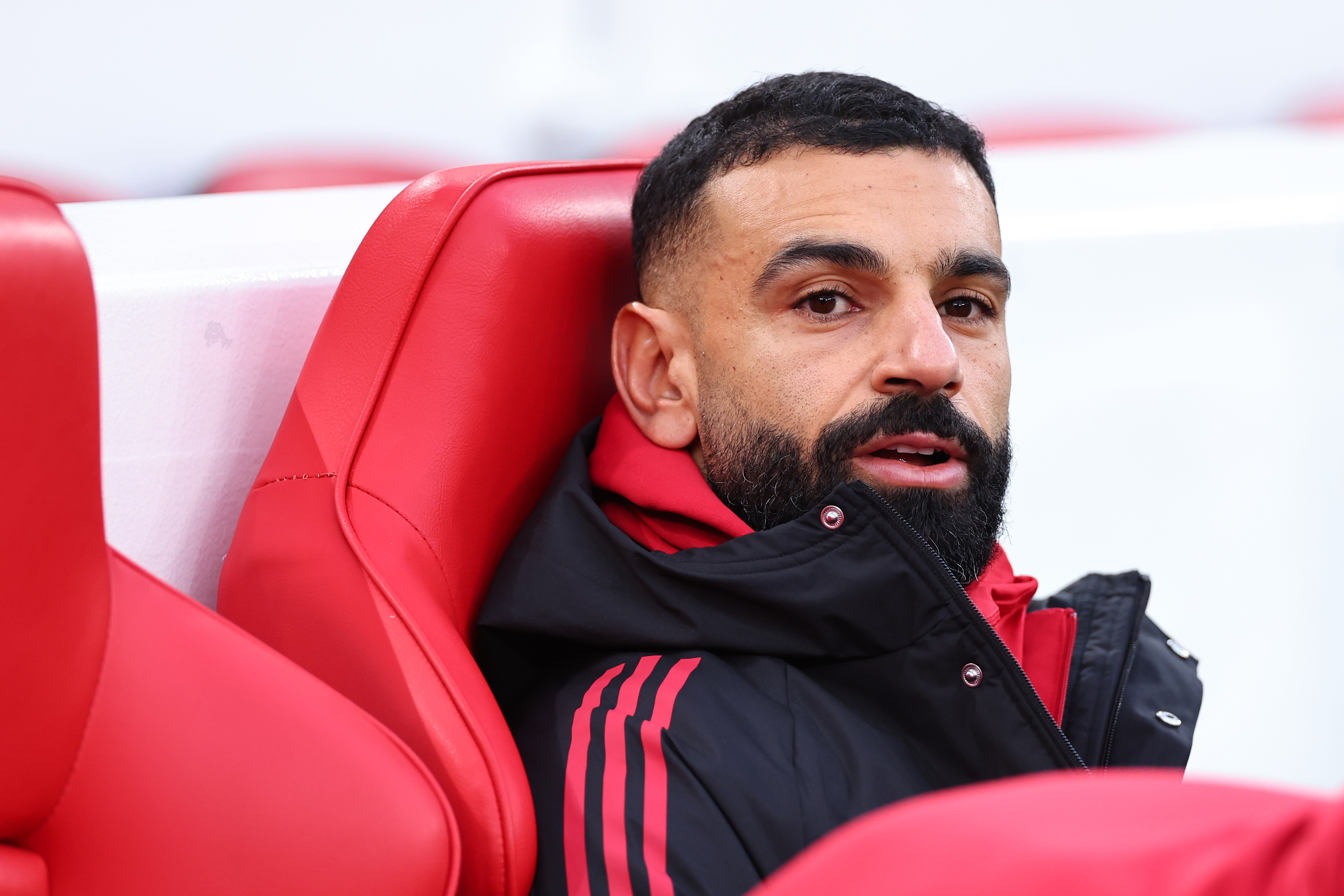5 things from Watford 1-2 Chelsea: Smart Hornets make Blues struggle for shape
John Robertson was at Vicarage Road to see the Blues invert the Orns. Here's what he thought, using the award-winning Stats Zone
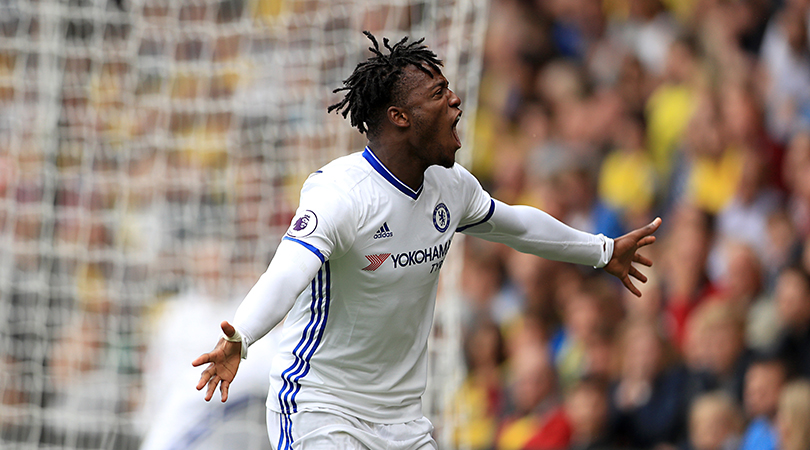
The Italians might be new to their current clubs, but Watford manager Walter Mazzarri and Chelsea’s Antonio Conte are familiar with each other following their time in Serie A. It’s Conte that’s likely to remember their meetings more fondly, however, the former Italy national team coach having lost just once in seven matches against Mazzarri.
Both men had more recent reasons to be happy coming into this second match of the season, though. Watford scored a hard-earned point away at Southampton on the opening day and Chelsea getting all three against a much-fancied West Ham United. This was Mazzarri’s first competitive home game with Watford, just as it was Conte’s away debut in the Premier League.
Watford started under the same 3-5-2 system that was used against Southampton with good effect, the hardworking pair of Troy Deeney and Odion Ighalo tasked with overwhelming Chelsea’s ageing backline.
Conte made just one change from the Monday night win versus West Ham, a calf injury forcing Willian out of the side and Pedro into it. Cesc Fabregas, again, could only find the bench.
1. Can Chelsea’s defence handle two strikers?
The ease with which Chelsea shackled Andy Carroll in their season opener would have been demoralising for the English striker, but the Blues’ defence found Watford far more difficult to intimidate. While John Terry and Gary Cahill just about managed to equal Ighalo and Deeney for physicality, the forwards’ persistence forced a number of positional mistakes from Conte’s back four – in particular, from the full-backs.
Watford’s goal came from a throw in the attacking third that was immediately crossed deep into the box. The cross was far too high for Ighalo or Deeney to attack, but their central positions forced Cesar Azpilicueta inside to assist Cahill and Terry. That left Etienne Capoue wide open on the right to pluck the ball out of the air and drive it past Thibaut Courtois. Given that Azpilicueta had moved inside, it could be argued that Pedro was the one at fault for not dropping back to cover.
The best features, fun and footballing quizzes, straight to your inbox every week.
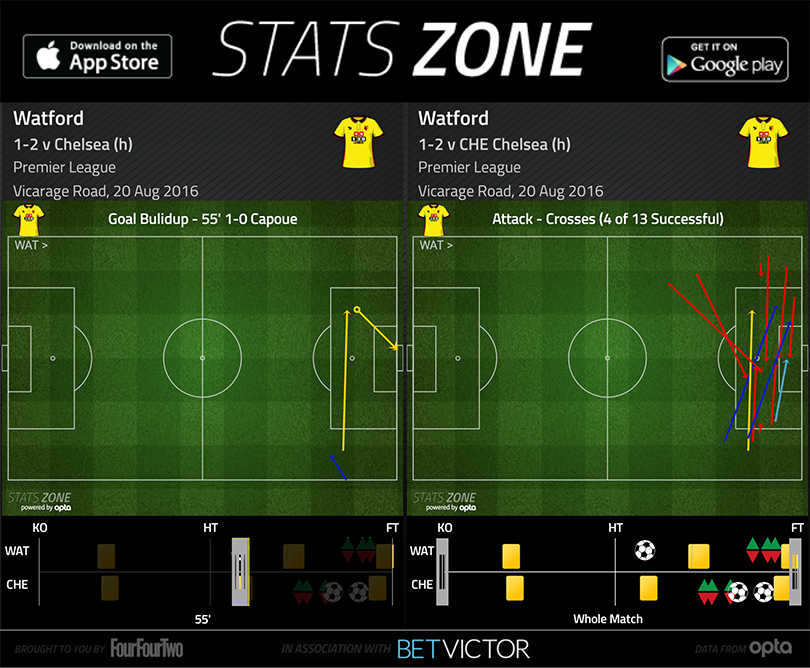
Providing that cover was difficult for Chelsea over the entirety of the 90 minutes due to Watford’s strict adherence to a counter-attacking system. Only when Pedro and Eden Hazard took up their usual, predictably offensive positions would Watford seek to strike. Usually this involved the defence getting the ball to Nordin Amrabat as soon as possession was won, the Dutch winger driving forward from a defensive position to incredible effect and looking to cross early into the path of Deeney and Ighalo. Indeed, Watford should have opened the scoring with exactly this kind of attack on 24 minutes.
By coming down the flanks Watford avoided the disruption that N’Golo Kante and Nemanja Matic are so keen on causing. Conte needs to come up with a solution as to how to minimise the pressure on Cahill and Terry in these situations, otherwise more talented teams are going to start copying Watford’s model against the Blues.
2. Kante straight down to business
The goal Chelsea conceded can’t be blamed on Kante. Chelsea’s marquee summer signing (so far) looks so assured in his role under Conte that you’d be forgiven for thinking the two have worked together for years. As he did against West Ham, the French international would frequently drop between defenders Cahill and Terry when Chelsea had possession in their own half, at times taking up a sweeper role behind the defenders and receiving the ball short from goalkeeper Courtois. Kante has greater passing ability than either of Conte’s two centre-backs, so giving him the responsibility of playing out from the back makes good sense.
Their front two ensured that Watford asked more questions of Chelsea’s defence than West Ham managed, but Kante proved himself integral to preventing the Hornets gaining any traction through the middle.
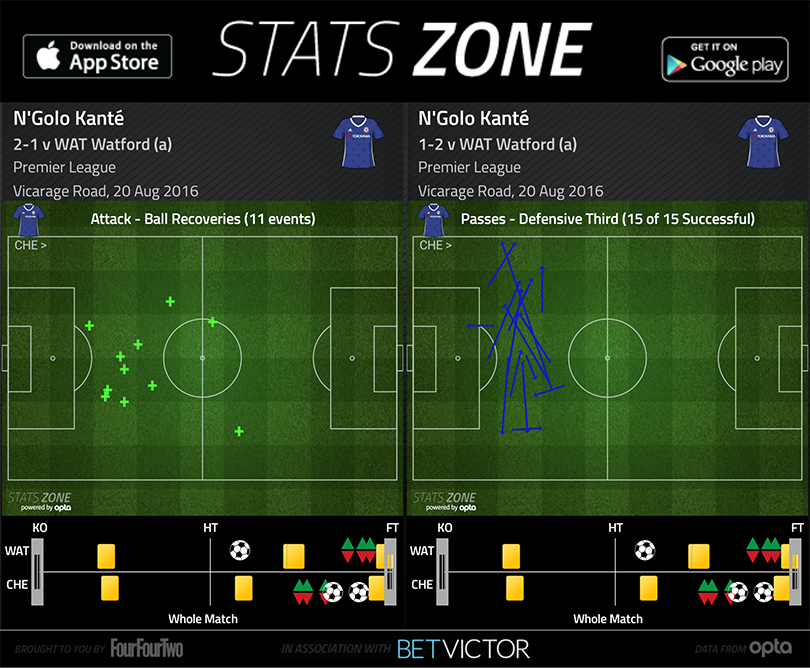
His relationship with Matic was key to this, the two showing signs of a blossoming partnership despite having played just a handful of matches together. Kante would take the deeper defensive role, tracking runners across the width of the pitch, while Matic defended from the front by pressing Watford’s more creative passers such as Adlene Guedioura and Amrabat when they came central with the ball.
Over the course of his first two games in charge Conte has prioritised a midfield that is tough, energetic and full of running. Kante and Matic are characteristic of that approach.
3. Blues struggling for creativity
Shutting down the middle of the field is no problem for Chelsea, in both defence and attack. For the second game in a row the midfield pairing of Oscar and Matic looked unconvincing from an attacking perspective, doing little to confuse or overwhelm Watford through the middle.
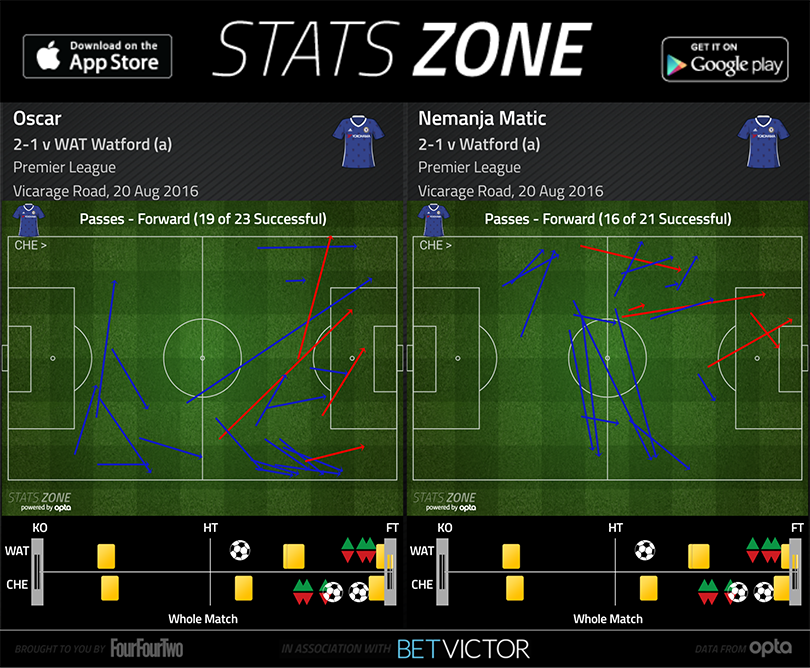
Matic did have a couple of moments in which he picked up possession in potentially dangerous positions on the left side of Watford’s box, but these fizzled out to nothing. Oscar failed miserably with every attempted assist he looked to create, shut down by both Watford’s defensive solidarity and his own struggles for ingenuity.
Until Conte introduced Michy Batshuayi and Cesc Fabregas, changes that completely rearranged his attack, his side looked incapable of scoring.
4. Watford’s 3-5-2 contained Chelsea’s
Prior to the substitutions that saw Conte adopt a 4-4-2 for the final 25 minutes, Watford had done an admirable job of keeping Chelsea quiet. Hazard was a menace throughout – continuing the stunning form he showed in the West Ham game – but his supporting cast were kept quiet by Mazzarri’s system of defending deep and striking with snake-like counter-attacking speed.
It’s normal for the back three of a 3-5-2 to morph into a back five when possession is lost, but Watford would often have seven devoted defenders given that midfielders Valon Behrami and Amrabat were so eager to take up conservative positions as soon as Chelsea moved past the halfway line.
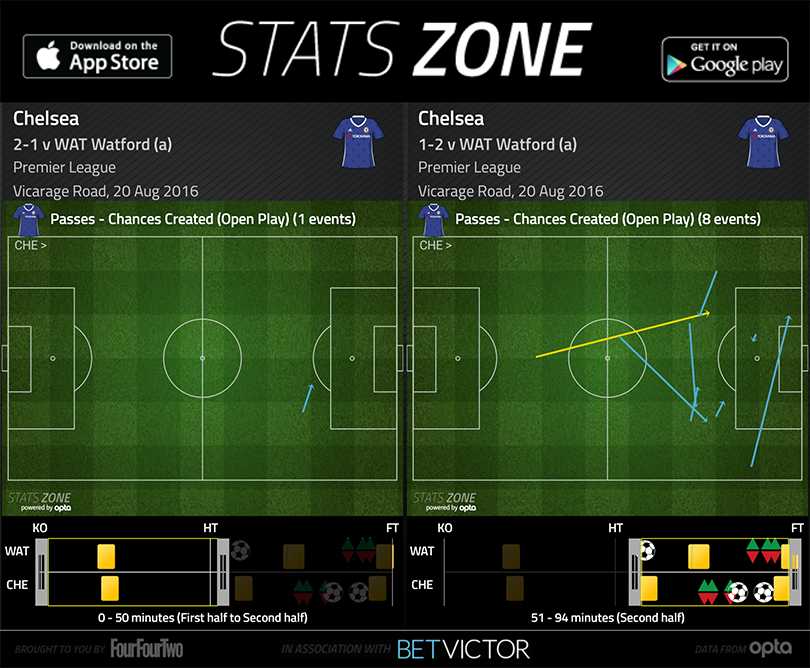
Chelsea didn’t help themselves. Conte’s wide players are loathe to simply cross the ball into the box, instead preferring to seek out higher percentage passing opportunities to feet; combined with the struggles the Blues experienced in creating chances through the middle, Costa in the first half looked as isolated as he has ever been; the entire team creating just one half-chance in the opening 50 minutes.
If Watford hadn’t decided to altogether give up on attacking following their goal – an approach that encouraged Conte to make overtly offensive substitutions – it’s entirely possible that they could have held on for the win.
5. The return of Fabregas?
A number of elements contributed to Chelsea overcoming the deficit to score two in the last 10 minutes of the match. Marrazzi’s instructions for his team to sit back and defend for the 35 minutes that remained following their goal was one, as was the introduction of Batshuayi to partner Costa in attack.
However, it was Fabregas’ first appearance of the season, replacing Matic after 78 minutes, that provided Chelsea the creative edge they had lacked up to that point.
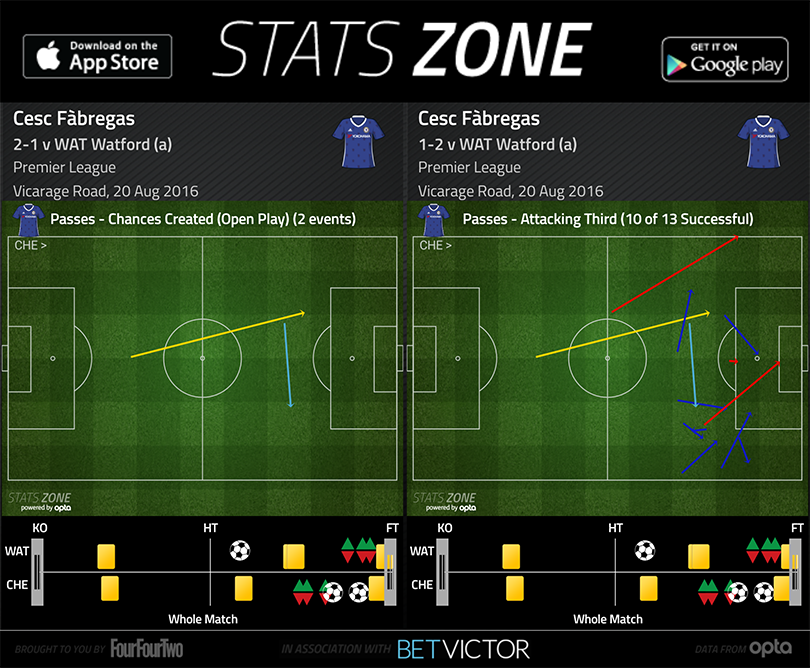
Even prior to the defence-splitting assist, executed from Chelsea’s own half of the pitch and sending Costa to score the winner, Fabregas displayed calm authority and assured distribution to make Watford panic and lose positional discipline. Rather than concentrating on adhering to the gameplan that had worked so well in the first half, they ceased to work as a team and worked to clog up passing lanes as individuals. Invariably, this left gaps that allowed Fabregas’ ability to flourish even further.
Conte now has an extremely tough decision on his hands. Does he continue with the midfield partnership of Oscar and Matic that has started both games thus far, or does he swallow his pride and admit that he perhaps made a mistake by not giving Fabregas a starring role from the outset?
Of course, maybe this was all part of the plan. Bench Fabregas to light the fire inside of him, then release him upon unsuspecting prey…
Match facts

- Diego Costa has scored in 3 consecutive Premier League games for the first time since January 2015.
- Since returning to the Premier League, Cesc Fabregas has more assists than any other player (26).
- Michy Batshuayi has either scored or assisted in both of his Premier League appearances from the bench so far for Chelsea.
- Eden Hazard collected just his second assist in 26 Premier League appearances.
- Etienne Capoue has scored in successive Premier League games, having scored 1 in 57 PL games before that.
- Adlene Guedioura has assisted in back-to-back home games for the Hornets.
- Chelsea have kept just 1 clean sheet in their last 8 Premier League games away from Stamford Bridge.
- Antonio Conte has lost just 1 of his last 32 league games as a club manager (W29 D2).
New features every day on FourFourTwo.com
STATS ZONE Free on iOS • Free on Android
